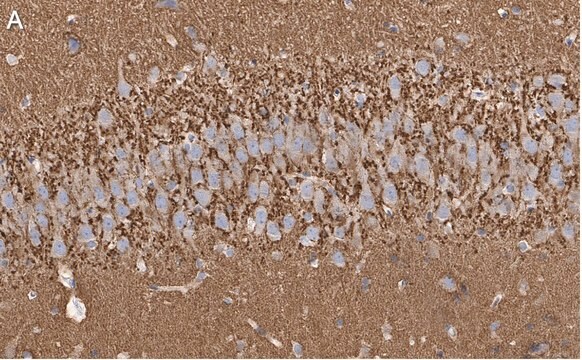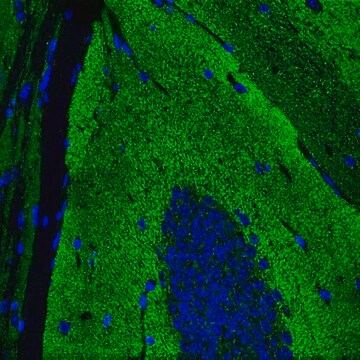AB9272
Anticuerpo anti-sinaptofisina
Chemicon®, from rabbit
About This Item
Productos recomendados
biological source
rabbit
Quality Level
antibody form
affinity purified immunoglobulin
antibody product type
primary antibodies
clone
polyclonal
purified by
affinity chromatography
species reactivity
human, rat
manufacturer/tradename
Chemicon®
technique(s)
immunohistochemistry: suitable (paraffin)
western blot: suitable
NCBI accession no.
UniProt accession no.
shipped in
wet ice
target post-translational modification
unmodified
Gene Information
human ... SYP(6855)
Specificity
Immunogen
Application
Neurociencia
Inmunohistoquímica en tejido fijado en formol e incluido en parafina: 1:300 durante 10 minutos a temperatura ambiente. La tinción de tejidos fijados con formol requiere hervir los tejidos en tampón citrato 10 mM, pH 6,0 durante 10 minutos, seguido de enfriamiento a temperatura ambiente durante 20 minutos.
El usuario final debe determinar las diluciones de trabajo óptimas.
PATRÓN DE TINCIÓN: Citoplásmico
Sinapsis y biología sináptica
Linkage
Physical form
Storage and Stability
Analysis Note
CONTROL POSITIVO: Páncreas o feocromocitoma
Legal Information
Disclaimer
¿No encuentra el producto adecuado?
Pruebe nuestro Herramienta de selección de productos.
Optional
Storage Class
12 - Non Combustible Liquids
wgk_germany
WGK 2
flash_point_f
Not applicable
flash_point_c
Not applicable
Certificados de análisis (COA)
Busque Certificados de análisis (COA) introduciendo el número de lote del producto. Los números de lote se encuentran en la etiqueta del producto después de las palabras «Lot» o «Batch»
¿Ya tiene este producto?
Encuentre la documentación para los productos que ha comprado recientemente en la Biblioteca de documentos.
Nuestro equipo de científicos tiene experiencia en todas las áreas de investigación: Ciencias de la vida, Ciencia de los materiales, Síntesis química, Cromatografía, Analítica y muchas otras.
Póngase en contacto con el Servicio técnico







